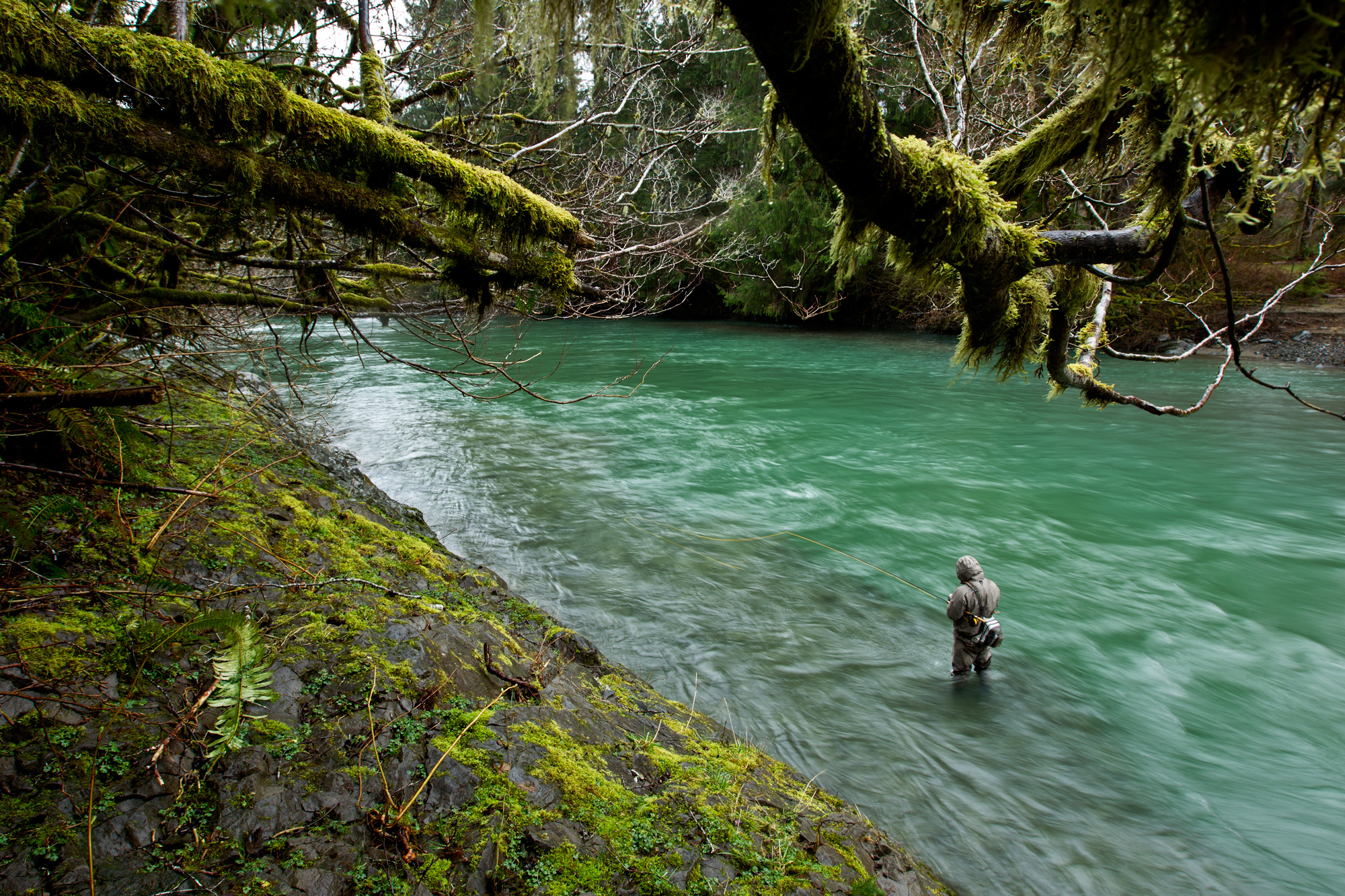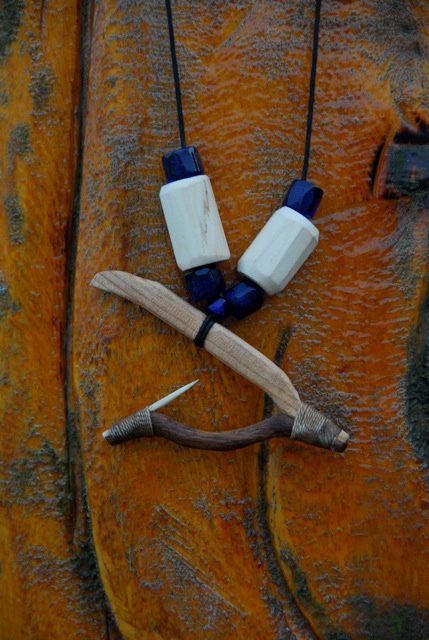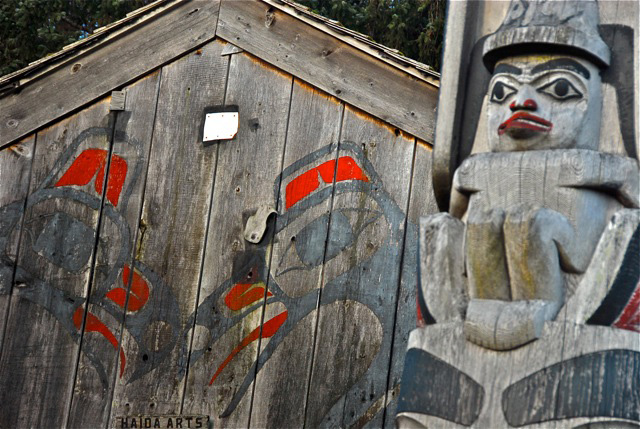
14 Jul Outside: Steelhead in the Magic Forestgreen on the Sol Duc
I first felt a need to step on the Queen Charlotte Islands back in the 1980s when a friend and I steered a 42-foot long wood trawler, called the Cape Cross, from the West Wall in Seattle through the inside passage to Petersburg, Alaska.
The trip took five days and went according to plan, except when we sailed into Queen Charlotte Sound, which is a wicked expanse between the north end of British Columbia’s Vancouver Island and the southern tip of the Charlottes. It’s fully exposed to the Pacific Ocean and has, over the centuries, swallowed its share of marine craft. We tried to cross the sound before weather pushed in, but were caught in a gale and spent hours navigating giant waves while stumbling about the cabin, picking up stray gear and hoping that our haste wouldn’t cost us our lives. By the time we cruised into Hecate Strait, which lies on the lee side of the Charlottes and offers protection from the Pacific, I wanted to be put aground on the nearest terra firma, which at that point was Moresby Island, the Charlottes’ second largest and most southerly land mass. However, there was nowhere to land; the coast of the island is composed of jagged rock, nearly impenetrable forest and wicked cliffs. Studying the shore I remember thinking, Well, that’s about as wild as it gets. So we steered on to Alaska.
The next time I heard about the Charlottes, which are now officially called Haida Gwaii, representing the desires of native Haida people, I was couch surfing in Seattle, resting at my parents’ house watching way more fishing shows than I should have. In one, some lucky dude had flown to the islands and was catching oversized native steelhead on a fly rod. By that time Pacific Northwest steelhead runs were failing miserably and I’d gone a season without even hooking one. I sneered at the TV host’s “I’m here/your not” attitude and thought, Hey, gloat now, I’m coming up there to catch your fish.
It took 15 years to follow through on that promise, but in early March 2009 my Pacific Coastal Airlines flight touched down in Masset and I was greeted by Jin Chong, who at that time was running a self-guided steelhead operation out of a lodge called Masset House. This was the deal: Chong, a Malaysian who used to cook at upscale Vancouver hotels, prepared breakfast, a sack lunch, and killer evening appetizers and meals. Between breakfast and dinner I used a shiny-black F-250 Ford pickup truck to cruise around Graham Island and access the Yakoun River at various points. I’d leave before light, drive for an hour and a half, hike through the forest and throw for steelhead all day. Then I returned to Masset House for a couple ice-cold Canadians, a dip in the hot-tub, and a feast on whatever Chong prepared as our meal, usually local fare, including razor clam chowder, grilled weathervane scallop, even octopus or Dungeness crab salad.
The arrangement was great, but skulking around the coastal forest alone while accessing a river that is only visible from the road in two places, scaling downed trees that match the dimensions of a 747 fuselage, sliding down steep banks and weaving around cliffs, all snow and ice covered, made me nervous. I kept thinking, If I snap a leg out here, who’s going to find me? And I feared an encounter with resident black bears, some of the largest in the world, which don’t necessarily hibernate and might be seen any day of the year.
The northern forests, ranging from western Washington north through southeast Alaska, capture my imagination — so inviting, peaceful and cathedral-like on one hand, entirely mysterious and menacing on another. I don’t believe in Yeti, I don’t subscribe to alien-abduction theories, and I probably don’t believe in Kustikaw, a devilish little cantankerous creature that starred in a sweet little book about southeast Alaska called The Strangest Story Ever Told. But, I still entertain hope that somewhere in the temperate rainforest, under 200-foot-high spruce, hidden by impenetrable underbrush, and fueled by any magic that is left in this world, Sasquatch may exist. And, if that beast is real, it’s likely stalking around Haida Gwaii, just out of sight of anglers, puzzling over why those strange humans expend so much energy to catch a fish that they simply release.
I ask the same question when steelhead are scarce, when throwing so many casts without a grab that I wonder if there aren’t other endeavors in this world that make more sense. But challenge and reward, patience and suffering, have a lot to do with what makes steelhead such a worthy pursuit and the capture of one much more memorable than, say, landing a 12-inch hatchery rainbow trout straight out of a stock truck. Fortunately, I didn’t have to wait long while fishing Haida Gwaii to capture that satisfying feeling.
Steelhead begin their spawning run in early November and continue to push into the Yakoun, and many other smaller streams, through mid-March. Steelhead populations on Haida Gwaii aren’t remarkable. Some have declined for years. Others, however, are stable and offer some of the best fishing in the Northwest for impressive 10- to 20-pound specimens. Even 30-pounders are possible.
The first fish I hooked on the Yakoun, five or six hours into my first day, was a silvery hen that stretched well past 30 inches and probably weighed 15 pounds; I’ll never know for sure, however, because she swam away with an orange and white marabou fly in her mouth. I cursed her early departure — my fault for wanting it too badly and trying to beach her before she was ready. But, my confidence soared, knowing that fresh fish were about and that I had four more days to throw at them.
On the third day, I was fishing a now familiar run where I’d hooked a steelhead on the first day. By this time I knew the current, the drift, the angles of submerged rocks and logs, and I swung my flies within inches of those obstructions, hoping to tempt another steelhead into a take. I’d been there for an hour when I heard a strange noise, a low growl.
It was unlike any sound I’d ever heard in the forest, irritated, threatening, dangerous. At first I didn’t believe what I was hearing. But my ears weren’t lying. I yelled, “Get out of here.” And another growl came from the forest, just across the stream on the far bank. I grabbed some pepper spray, peered into the forest, and held my ground. But I never saw the source of that sound. Could it have been Squatch? A black bear? Something else? Who knew. Later, I checked the area for tracks and couldn’t find anything more substantial than squirrel prints. It was as if an animal had dropped from the sky and retreated the same way.
Magic. The locals believe in it and there’s tangible reason for them to do so. For instance, the town of Port Clements, near the mouth of the Yakoun, harbored an incredibly rare resident white raven that entertained locals and passersby until 1995 when it winged into a power-line and was electrocuted. Stranger yet was a 165-foot tall Sitka spruce tree that grew brilliant golden needles, instead of the standard issue green. The Haida people wove the tree into their mythology. Biologists described the spruce as built by magic. For the rest of us, standing in front of the golden spruce lets us believe that anything is possible.
Then, in 1997 an eco-terrorist named Grant Hadwin decided that the best way to draw attention to British Columbia’s consumptive forestry practice was to saw down the miracle tree. He travelled to Haida Gwaii in the middle of winter, crawled into a wetsuit, strapped a chainsaw to his back, and swam down the Yakoun. He placed other gear — wedges, gas, files, etc. — in inflated plastic bags and floated those to the golden spruce. During the night he sawed irreparable, lethal cuts into the tree, then wedged those slashes so that the golden spruce would fall across the river, instead of into the forest, where it would be easily seen and his protest announced. During the next windstorm the tree fell and all hell broke loose. By that time Hadwin had contacted the authorities and media and was validating his act. He was arrested and a court date was set. Threats to his life were common. Despite those threats, he promised attendance in court. To reach Masset from the mainland, however, he set sail in a sea kayak from Prince Rupert and tried to paddle across Hecate Strait. He hasn’t been seen again. Wreckage of what is believed to be his kayak was found farther north in southeast Alaska. Many believe he survived and is now living in Russia. Others say someone killed him on the way to Masset. Either scenario seems plausible.
Hadwin isn’t the only interesting criminal to have set up camp on the islands. Another, Stephen Reid, was part of the Stopwatch Gang, a group of men who robbed 100 North American banks in the 1970s and 1980s, including a score of six gold bars, worth $700,000, from the Ottawa airport in 1974. He and his partners achieved folklore status for their considerate treatment of civilians, but the authorities weren’t amused and sentenced him to 14 years in prison, where he penned the fascinating book, Jackrabbit Parole. That caught the eye of the rebellious Canadian poet Susan Musgrave and the two later married in a penitentiary, surrounded by razor wire. After Reid was paroled, he and Musgrave spent much of their time on Haida Gwaii, just a few miles east of Masset, or in Victoria, on Vancouver Island, living in a tree house. Reid was crime-free and family oriented for years, but in 1999, drug-fueled and dressed as a police officer, he strapped a sawed-off shotgun to himself and robbed a branch of Victoria’s Royal Bank. He fled with $92,000, but was taken into custody shortly after and sentenced to 18 years in prison. He was paroled in 2008 and again spends time with Musgrave on Haida Gwaii.
While walking around Masset one day, shooting photos and taking a break from the redundancy of swinging flies for steelhead, I ran into an artist who showed me a necklace. It was a rendition of a traditional Haida fishing hook, with a V-shaped wood structure tipped with a narrow, pointed, sharp piece of bone. One portion of the V was carved out of traditional Sitka spruce. The other piece was carved, he said, from the golden spruce. I continued my trek and saw traditional native coastal art wherever I looked, some in the form of totems, some in jewelry, some in painted murals on the sides of cedar houses, some in traditional canoes, some just carved out of tree stumps. I even saw a custom cut, stainless-steel radiator guard, embellished with a traditional eagle design, on a supped-up Dodge Ram pickup truck. Later, when traveling from Masset to Sandspit to catch an Air Canada flight back to Vancouver, I stopped at the 53,000-square-foot Haida Heritage Center, which opened in August 2008. The center consists of five cedar longhouses and a carving shed where local artists craft traditional canoes and paddles, totems, and even bentwood boxes, which are four-sided containers crafted from a single piece of cedar that is steamed and bent. Those boxes were used to house treasured gifts and given away at potlatches. Today, those boxes are purchased by collectors and fetch between a couple hundred and a few thousand dollars. I grew up in southeast Alaska and have seen a lot of coastal art, but never the quantity or quality found on Haida Gwaii.
As the week progressed the Yakoun continued to drop and the fish became almost nocturnal, leaving their secure lies only late in the day, as light faded. Each afternoon brought two or three steelhead to the bank and the bonus of a couple sea-run cutthroat trout. Some were chrome bright, others painted reddish/orange by their spawning run and time in freshwater. Each, I considered a treasure, fish of merit based on their beauty and fighting ability, coupled with an element of challenge and reward. You know, it’s not easy casting all day to a fish you can’t see, while standing in nearly freezing water, blowing on your hands to make them function. I fished in solitude, far from any town, by myself, in a wild forest, with the risk of injury riding on each step. At times I fished hard, other times I sat on the bank of the Yakoun and counted my good fortune. I even visited the site of the golden spruce, contemplating Haida Gwaii history, culture, outlaws, and that compelling art. And I thought specifically about Hadwin’s act. The tree was gone, for sure. But the myths survive, along with a strange sensation — hidden by that forest, where you could willingly wander off and disappear, anything still seemed possible.
- Photo by Drew Stoecklein
- Walking through he coastal forest alone. Accessing a river which is only visible from the road in two places was an adventure getting through downed trees, sliding down steep banks and weaving around cliffs through impenetrable underbrush.









No Comments